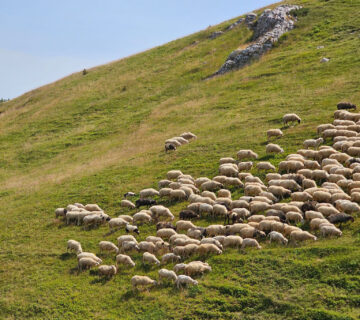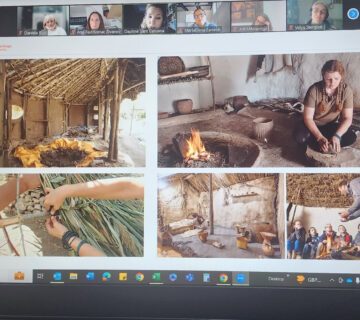
AR app used in museum setting (Image: Velendecic)
Dealing with learning in museums for the past 40 years, the curators of the Museum of Vojvodina have designed programmes for all visitor categories. One of the main goals of their diverse activities is the creation of the permanent museum audience. In order to achieve this goal, interesting exhibitions and the accompanying programmes, combined with good marketing, are not enough. It presumes a continuous development of didactics and a museum content strategy. Investing energy, knowledge and experience on the one hand, and following the trends of contemporary museological practice on the other, we strive to improve interpretive methods, considering it to be one of the factors that influence the creation of cultural needs, especially for the youngest visitors as future consumers of cultural content.
The inspiration for the Museum e-KnowAll app was an interactive picture book (Muzejska lepezica/ Museum Fan), published in 2014 by the Museum of Vojvodina, which consists of 50 sheets, each containing basic information, questions or tasks. Having in mind the necessities dictated by the digital transformation era and basic ecological demands, we decided to design a modern version of this picture book and named it the Museum e-KnowAll. In a similar form to the printed edition of the book, this mobile device app assumes didactical content, which is designed into different types of tasks.
The basic content consists of ten stories about different museum exhibits or phenomena, such as Life in Prehistoric Times, Toys and Jewellery in Prehistory, Ancient Rome – Gilded Roman Helmets, Handwritten Manuscripts, Means of Transportation, Crafts, Traditional Architecture, Agriculture in Vojvodina, Lighting in the Past, Festive Women Caps. These short stories are told in Serbian and English by three animated characters (a curator, a boy and a girl), who appear in augmented reality (AR). The fact that they are told by children makes the stories more appealing to the key audience (children).
Each story is followed by a task, which is created in such a manner to encourage interactivity. There are different tasks, such as: find the missing part; link the toy with a similar one from the past; take a selfie; choose the correct answer; chronological sequence; connect the terms; find differences; link names and subjects; listening-based recognition; mark the intruder.
The app is made for children aged four to six years, so it can be used as a teaching method in preschools. Considering the fact that they have to visit the museum accompanied by an adult, the use of this app initiates the parent-child or child-elder bonding. The content is recorded in audio format, so it can easily be used by children who are not capable of reading.
Museum e-KnowAll can be downloaded for free from the Google Play or App Store. It is a marker-based app, in which specifically designed markers act as triggers. In order to be used within the permanent exhibition, recognisable markers show the visitor where the app should be used. If the visitor doesn’t have a mobile phone, tablets are available to borrow.
A printed brochure with markers can be bought in the museum shop. Apart from increasing the number of users, this also promotes the museum and encourages motivation to visit. But it also provides a method for children who are not able to visit the museum to learn about it from their homes.
Slađana Velendečić is Head of the Educational and PR department of the Museum of Vojvodina, where she has been employed since 2000. She has participated in the design and realisation of many educational programmes. Her main interest in museum work is related to education and interpretation. She can be contacted at: slacka73@gmail.com.
Tijana Stanković Pešterac is Assistant Director of the Museum of Vojvodina in Novi Sad. She has organised exhibitions as an author, lead many different projects (concerning archaeology, digitisation and museum education and interpretation), published catalogues, as well as scientific and popular articles. She can be contacted at: tijana.pesterac@muzejvojvodine.org.rs.
To cite this article:
Velendečić, Slađana and Stanković, Tijana (2020) ‘Museum e-KnowAll – Culture and virtual adventure ‘. In Interpret Europe Newsletter 1-2020,
18-19.
Available online:
www.interpret-europe.net/fileadmin/Documents/publications/Newsletters/ie-newsletter_2020-1_spring.pdf




